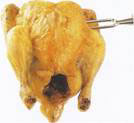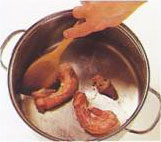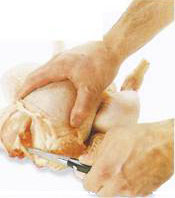|
|
|
Poultry safety
Raw poultry can carry bacteria such as salmonella. To reduce the risk of food poisoning,
it is vital to store and handle poultry properly and to cook it thoroughly. Wash
your hands and all utensils in hot soapy water. Keep a cutting board just for raw
poultry (preferably one that can be scalded, or washed in a dishwasher). Never let
raw poultry (or its preparation utensils) come into contact with cooked poultry
or meat. Don't stuff a bird until just before cooking and make sure the stuffing
is cold. It's best to ensure that the stuffing is cooked thoroughly before being
placed in the bird.
POULTRY & GAME KNOW-HOW
POULTRY IS THE TERM applied to all domesticated farmyard birds and includes chicken,
turkey, geese, and duck. Chicken is sold whole, in pieces, or cut into boneless
pieces, and lends itself to an infinite variety of recipes. Turkey is equally versatile
and you can now enjoy whole birds, breasts, and boneless breasts or cutlets at any
time of year. Though eaten less frequently, the richer, fattier meat of duck and
goose has a truly wonderful flavor, as does the leaner meat of game and game birds
.
BUYING & STORING
Poultry and game birds should have a plump breast and moist skin. Poultry should
smell fresh and sweet. Game birds, which are aged to tenderize their flesh and to
enhance their "gamy" flavor, should nevertheless have an appealing odor. They should
be hung in a cool, well-ventilated place for 2 days during warm weather and for
up to 2 weeks during cold weather.
There is a great variety of poultry available. With chicken, for instance, the cook
can choose free-range birds that have been allowed to roam in the open air and have
been fed a diet of grain. They are more expensive but are thought to have a superior
flavor. Corn-fed chickens are another option; their diet gives their flesh a yellow
color and a delicious flavor. Chickens range in size from Rock Cornish game hens,
which serve 1-2, to oven-ready birds weighing from 3 lb (1.5 kg) up to 6lb (3 kg)
or more. Turkeys can weigh as much as 30 lb (15 kg).
Poultry and game are very perishable, so they must be kept cool. Remove any tight
plastic wrapping and giblets and refrigerate the bird, loosely wrapped, immediately.
It's a very good idea to set the bird on a plate to collect any drips. Cook smaller
birds within 2 days of purchase and store goose and turkey for up to 4 days.
THOROUGH COOKING
Cook poultry thoroughly to kill any bacteria.
If you are roasting a whole bird, lift it on a long fork - the juices that run out
should be clear. Insert a skewer into the thickest part of the meat and check the
color of the juices. Large birds are best tested with a meat thermometer - the internal
temperature should be 190癋 (90癈) when properly cooked.
Microwaving
Casseroles and stews made from poultry and game can be cooked quite easily in the
microwave oven. They are quick to prepare and when cooked properly, the meat stays
tender and juicy. You may choose to brown the poultry or game and any vegetables
on top of the stove first, then transfer the dish to finish cooking in the microwave
oven. If you use two different pans, be sure to transfer the flavorful pan drippings
to the casserole in the microwave as well.
Roasted game and poultry are best cooked in a conventional oven; however, the microwave
oven can speed up the process by quickly thawing meat that has been frozen.
|
|
Freezing
To freeze poultry and plucked, oven-ready game at home, wrap it well and freeze
without delay. When buying frozen poultry and game, check that it is completely
frozen and transport it home as quickly as possible. Chicken, turkey, game birds,
and small game animals can be stored in the freezer for 6 months; duck, goose, and
guinea fowl can be kept for 4 months; and large game animals for 8 months.'
Poultry and game must be thoroughly thawed before cooking. Pierce the wrapping and
set the bird on a plate in the refrigerator (or use the microwave). Remove the giblets
as soon as possible. Never refreeze raw poultry or game.
|
POULTRY OR GAME STOCK
To make 10 cups (2.5 liters) stock, use 3lb (1.5 kg) poultry or game pieces, the
carcasses and trimmings from 3-4 chickens, or a turkey or a whole chicken.
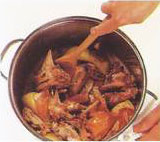
1 Put the cooked or uncooked bones into a stockpot or large pan with 2 or 3 halved
unpeeled onions. Cook until browned. If using a whole chicken, brown just the onions,
not the bird.
|
|
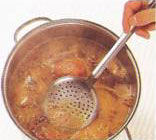
2 Add 4 quarts (4 liters) water. Bring to a boil, skimming off any scum from the
surface. Add 3 chopped carrots, 3 chopped celery stalks, 1 large bouquet garni,
and a few black peppercorns.
|
|
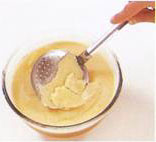
3 Half cover the pan and simmer for 2'/2-3 hours. Strain the stock into a bowl.
Leave to cool, then remove the solidified fat from the surface of the stock and
discard. Cover and keep in the refrigerator for up to 3 days or freeze for up to
3 months.
|
GIBLET STOCK
Use the giblets from 1 or 2 birds (poultry or game), excluding the liver.
-
In a stockpot or large saucepan, cook the giblets until lightly browned. Stir
in 1 quart (l liter) water (or previously made stock). Bring to a boil, skimming
off any scum that forms on the surface.
-
Add 1-2 quartered unpeeled onions, 1 chopped carrot, 1 chopped celery stalk, 1
bouquet garni, and a few black peppercorns. Simmer for about 1 hour. Cool, cover,
and keep in the refrigerator for 3 days or freeze for 3 months. Strain before use.
JELLIED STOCK
This stock is used in cold dishes such as raised pies, where it forms a jelly around
the meat. Make it in the same way as other stocks, but use bones only, rather than
a whole chicken or other meats, since bones contain a high level of gelatin. Crack
the bones before adding them to the pot. The stock will set when cool.
Stock know-how
- Do not add salt when making stock because it may be reduced in recipes to concentrate
the flavor.
- Peppercorns, instead of ground black pepper, are' used in stock. Prolonged cooking
can turn ground black pepper bitter.
- Skim fat with a large spoon, soak it up with paper towels, or allow to cool and
lift it off.
CUTTING UP A CHICKEN
Chicken pieces are widely available, but cutting a bird into serving pieces is not
at all difficult to do yourself, and it can be done before or after cooking. A pair
of special poultry shears makes the job particularly easy; otherwise, use good,
strong scissors or a sharp chef's knife.
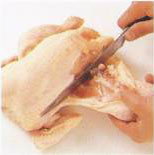
1 Cut through to the joint between one of the legs and the body. Twist the leg out
and away from the body to pop the ball-and-socket joint, then cut through the joint
to remove the leg. Remove the second leg.
|
|
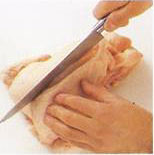
2 To remove the breasts, cut through the skin and flesh along both sides of the
breastbone. Cut through the bones of the rib cage where it joins the sides of the
breastbone, then remove the breastbone.
|
|
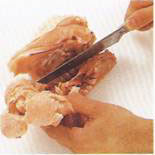
3 Open up the bird and cut along the backbone to give 2 breasts with wings attached.
For 8 pieces, cut each breast diagonally in two: the wing half should be slightly
smaller. Cut each leg through the joint.
|
BONING A WHOLE CHICKEN
Although boning a chicken requires a little time and effort, the result is impressive.
Stuffed and rolled into a ballotine, it is ideal for entertaining because it is
so easy to carve. Other birds can be boned in the same way.
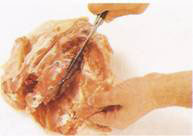
1 Set the bird breast side down and slit the skin along the backbone. Remove the
wishbone (page 150). Slide the knife into the cut and gently pull and scrape the
flesh away from the rib cage. Continue cutting away the flesh until you reach the
leg and wing joints.
|
|
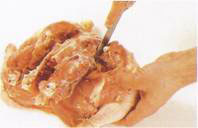
2 Scrape away the flesh from the other side of the rib cage. Be careful not to make
any holes in the skin as you bone the bird. Cut through the ball-and-socket joints
connecting the thighs to the bird.
|
|
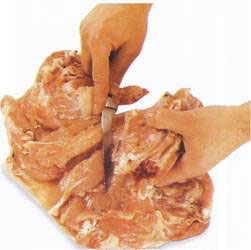
3 Keep cutting until you reach the breastbone in the middle. Cut the breastbone
free without cutting through the skin. Press each leg out and away from the body
to pop the ball-and-socket join t.
|
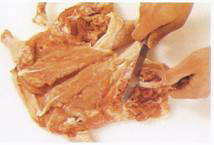
4 Cut through the tendons that join the legs to the body. Cut and scrape back the
flesh until the bones of each leg have been freed, then pull out the bones.
|
|
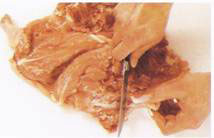
5 Bone the wings in the same way as the legs. The chicken is now ready for stuffing
and rolling. Keep the carcass and bones of the bird for making chicken stock.
|
BONING A QUAIL
For a special occasion, tiny quail can be boned but left whole. Then it's simple
to fill them with a savory stuffing and secure with a toothpick, ready for roasting.
Make sure you use a very small knife and be careful not to pierce the skin
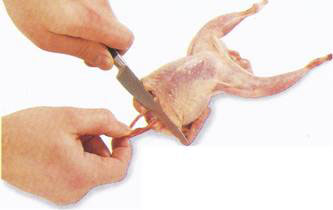
1 With your fingers, carefully loosen the skin at the neck of the quail and push
it back to reveal the wishbone. With a small, sharp knife, cut the flesh from around
the wishbone to remove it.
|
|
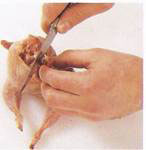
2 Loosen 1 wing by carefully cutting through the tendon at the base. Repeat with
the other wing.
|
|
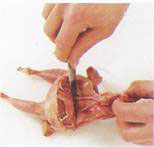
3 Insert the knife between the rib cage and the flesh and, working all around the
bird, scrape the flesh from the bones, pushing it back as you go. Remove the rib
cage. The bird is now ready to stuff.
|
SPLITTING POULTRY FOR GRILLING
This method of splitting and flattening a bird makes it quicker to cook and suitable
for grilling or cooking over a barbecue. Rock Cornish game hens, chickens, and game
birds can all be split for grilling.
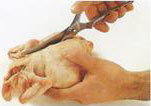
1 With poultry shears or a knife, cut along both sides of the backbone and discard.
Cut off the wing tips and the ends of the legs. Remove the wishbone.
|
|
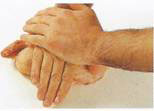
2 Turn the bird over. Put your hands on top of the breast and press down firmly
with the heels of your hands to break the breastbone and flatten the bird.
|
|
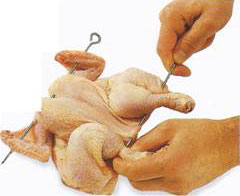
3 Thread a long metal skewer through the bird at the neck end, passing through the
wings. Thread another skewer below the breast, passing through the legs. If small
birds are split and flattened, 2 or 3 can be threaded on the same skewers.
|
PREPARING POULTRY FOR ROASTING
Tying or skewering a bird before roasting holds it together so that it keeps a neat
shape during cooking. It will also prevent any stuffing from falling out. Be sure
the stuffing has cooled completely before it's placed into the bird.
Trussing with string
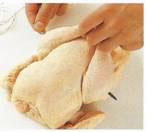
1 Thread a trussing needle with string. Put the bird breast
side up. Push the legs back and down. Insert the needle into a knee joint, through
the bird, and then out through the other knee.
|
|
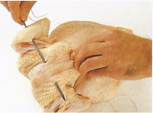
2 Pull the neck skin over the cavity and tuck the wing tips over it. Push the needle
through both sections of each wing, through the neck skin, and beneath the backbone.
|
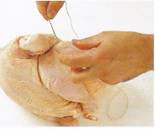
3 With the bird on its side, pull the string tightly, tie the ends together, and
trim. Tuck the tail into the cavity and fold the top skin over it.
|
|
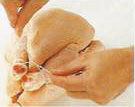
4 Push the needle through the top skin. Loop the string around one of the drumsticks,
under the breastbone, and around the other drumstick. Pull the string tight and
tie the ends.
|
Simple trussing
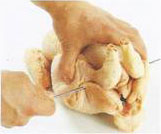
1 Put the bird breast side up and push the legs back and down. Hold
the legs with one hand, insert a skewer below the knee joint, and push it through
the bird.
|
|
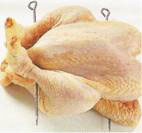
2 Turn the bird over. Pull the neck skin over the cavity and tuck the wing tips
over it. Push a skewer through 1 wing, the neck skin and out through the other wing.
|
REMOVING THE WISHBONE
A bird is easier to carve if the wishbone is removed before cooking.
With your fingers, loosen the skin from the flesh at the neck end. Fold back the
skin to expose the breastbone. Use a small, sharp knife to cut the wishbone free,
taking any fat with it.
CARVING DUCKS & GEESE
Once cooked, small ducks need simply to be cut into quarters or even halves for
serving. Larger ducks and geese can be carved as for other poultry.
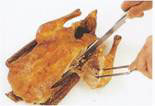
1 Remove trussing. Cut through the joints between legs and body to remove the legs.
(Cook them longer if necessary.) Cut the wings in the same way.
|
|
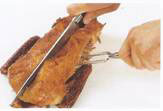
2 Slit the skin along both sides of the breastbone. Slide the knife blade into the
cut on one side to free the breast meat in a single piece. Repeat on the other side.
|
|
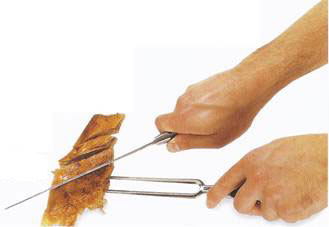
3 Carve the breast meat in diagonal slices. For a larger bird, carve the breast
meat without removing it first, as for a chicken.
|
CARVING POULTRY
Leave a bird to rest for about 15 minutes before carving. First remove any trussing
string or skewers, then spoon stuffing into a serving dish.
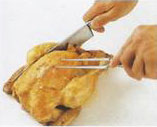
1 Put the bird breast side up on a carving board (ideally one with a well to catch
all the juices). Insert a carving fork into one breast to keep the bird steady,
then cut into the joint between the far leg and body.
|
|
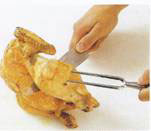
2 Turn the bird on its side and cut away the meat close to the backbone, cutting
around the "oyster" meat on the back so that it remains attached to the thigh. Turn
the bird over.
|
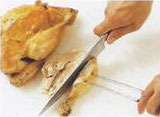
3 Twist the leg outward to break the joint, then cut it to remove the leg and the
thigh. If preferred, divide into thigh and drumstick, cutting through the ball-and-socket
joint. Remove the other leg.
|
|
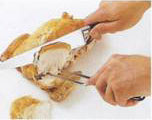
4 Make a horizontal cut into the breast above the wing joint on one side, cutting
all the way to the bone. Carve neat slices from the breast, holding the knife blade
parallel to the rib cage. Repeat on the other side.
|
Roasting know-how
- To calculate roasting time, weigh the bird after you have added any stuffing. Do
not stuff duck or goose.
- Cover large birds loosely with foil to prevent the skin from becoming too browned.
- Place fatty birds, such as duck and goose, on a rack to allow the fat to drain away
and keep the skin crisp.
|

